#Semantic segmentation
Explore tagged Tumblr posts
Text
The Perks of Being Open-Source
As promised, here's something about the plug-ins for Stable Diffusion, the only AI image generator that's open-source, and makes for a great testbed for related research because of that.
The outcome of this research are various plug-ins and modifications that allow Stable Diffusion to do a lot of interesting things. And the authors? Hooboy, you would be surprised. It turns out that very serious companies, ones you would suspect of cooking their own tech of this kind on the side even if they haven't announced it publicly, build interesting things and share it for free.
Let's start with Semantic Segmentation. If an AI image generator makes images based on text input, Semantic Segmentation scans images, identifies elements and assigns text descriptions to them. A lot of serious companies have released open-source code of their implementation: you have Nvidia, Google, Meta and even Alibaba building that stuff. It might sound kinda underwhelming if fairly useful for helping visually impaired people (for example, Facebook uses it to generate alt texts for images posts automatically), but here's the kicker: Semantic Segmentation may be used in Stable Diffusion to automatically generate masks based on text description. Want to find a hand and redraw it to be more anatomically correct? Easy. How about changing the hair color without monkeying with it in Photoshop? Also easy. So easy that some basement-dwelling chud can script it to find the clothes on a woman and draw a nude body in their place (and did, and got himself in trouble when another teenage chud uploaded photos of girls from his class to the app).
Semantic Segmentation is the core of the popular Stable Diffusion extension called aDetailer: as I mentioned before, Semantic Segmentation can recognize what a hand is, even if it's distorted, and point the generator to inpaint a better version in its place. Same goes for the faces. And that's the two things aDetailer is built to fix.
Another thing are ControlNets: plugins that allow you to nudge the generation process a particular way, be it recreating the pose of a character down to hands and fingers (or just the face orientation and expression), following the outline of a sketch and filling in the details, even maintain perspective using depth maps. And then, based on that tech, you have PhotoMaker, created by Tencent's Applied Research Center, and its improved version, IP Adapter. The capabilities are impressive, particularly if you remember that a slightly outdated gaming PC can run Stable Diffusion at a decent pace with no need for an internet access, even with the plugins.
Also, with OpenAI's video generator Sora looming on the horizon, you should know that the first AI-generated (or at least redrawn) videos were created in Stable Diffusion as well. I don't intend to go down this rabbit hole for practical reasons (I have no need for using it for that particular purpose and my video card is a bit outdated), but it was on the sweaty basement-dwelling nerds to figure out how to fine-tune the whole thing to be consistent across a whole fuckton of frames, and they did it, the crazy sonsabitches.
So laugh all you want at the ornery, wobbly Stable Diffusion producing rounded, fractal blorps and fucky hands. Even basic capabilities like inpainting and outpainting still make Midjourney jealous, and if you look at the plugins, you can imagine a good few use cases you could never wring out of the competing algorithms - and run them on your own PC for free instead of relying on centralized black boxes with a monthly fee.
#mike's musings#AI image generation#Stable Diffusion#IP Adapter#ControlNet#Semantic Segmentation#SemSeg#tech#technology
0 notes
Text
What are Smart Cities?
As Internet-of-Things (IoT) technology has gone mainstream, you may have heard of the smart home, but have you heard of the smart city? If not, you may be hearing more about these soon as smart cities using computer vision AI and a large network of information and communications technologies (ICT) are becoming a reality.
In a smart home, networked automation devices like smart thermostats, automated lighting and smartphone-controlled door locks allow homeowners to keep tabs on everything going on in and around the home using computers and smart devices. In a smart city, the same concept applies, just on a massive scale.
Increasing Municipal Efficiency
One of the biggest goals of smart cities is to improve efficiency. When large numbers of people, vehicles, residences, stores and government offices are crammed into tight quarters, trying to keep the gears of a city running smoothly can be difficult. Government agencies tasked with carrying out official duties tend to have a harder time as city populations grow, but the smart cities concept can help.
Think about this: In a traditional city, traffic management is a big job. If roadwork needs to be completed, traffic needs to be diverted and traffic signal operations may need to be changed. In a smart city, computer vision AI can monitor areas where traffic has been diverted to intelligently change traffic signals to create more efficient traffic patterns. This reduces the labor required for city officials and can reduce accidents as well.
Reduced Crime is a Benefit
Smart cities may also be safer due to connected technologies. In a traditional city setting, a gunshot that goes off in the commission of a crime may go undetected by people outside the immediate vicinity of the shot.
In a smart city, audio sensors that are trained to listen for gunshots can immediately detect the sound of the shot and pinpoint its location by measuring the echoes off of nearby structures. Simultaneously, the sensor can send a recording of the shot along with a video of the area and a notification to the nearest available police unit. A faster response time leads to more bad guys behind bars and safer communities for all.
Read a similar article about annotation services for computer vision here at this page.
#video annotator#active learning machine learning#cvat#semantic segmentation#computer vision in government#computer vision ai#radiology annotation software
0 notes
Photo

Exploring Image Analysis at the Pixel Level| Semantic Segmentation Services| NextWealth
NextWealth's Semantic Segmentation Services enable in-depth image analysis by providing pixel-level understanding, empowering accurate computer vision applications and unlocking valuable insights.
Read more :https://www.nextwealth.com/3d-semantic-segmentation-services/
0 notes
Note
arlecchino and signora x male reader for my copium please 🥺 can be either SFW or NSFW or both AHAHAHAHA
Thank youu
-Can I be 🤡 or 🐨?
Bouta use 🤡 on you for not reading my rules dawg ☺️
#hazy segments!#i really don't wanna start going men dni cmon :(#if you're gonna ask me to write something then at least mind my boundaries#however semantic they are
17 notes
·
View notes
Text
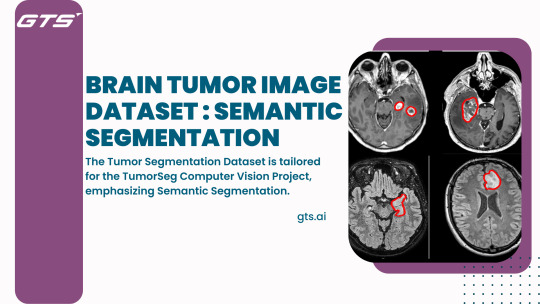
AI and healthcare seamlessly converge for the greater good. The journey has just begun, and with each pixel meticulously segmented, we step closer to a future where technology enhances, empowers, and saves lives.
#ai#data collection company#globose technology solutions#Brain Tumor Image DataSet : Semantic Segmentation
0 notes
Text
Medieval Scorpions Effortpost
So yesterday I reblogged this post featuring an 11th-century depiction of the Apocalypse Locusts from Revelations, noting the following incongruity as another medieval scorpion issue:
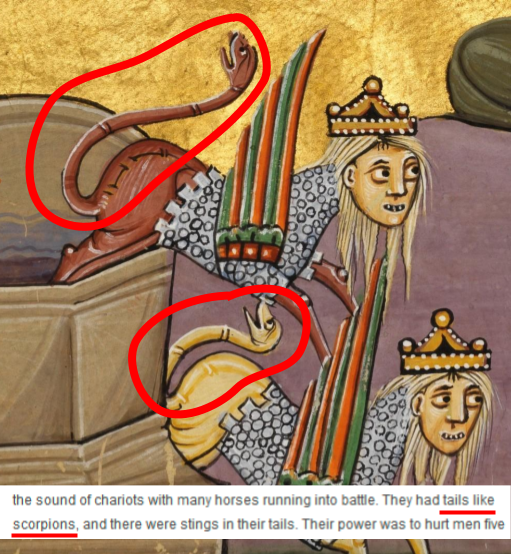
The artist, as you can see, has interpreted "tails like scorpions" as meaning "glue cheerful-looking snakes to their butts".
Anyway, it occurred to me that the medieval scorpion thing might not be as widely known as I think it is, and that Tumblr would probably enjoy knowing about it if it isn't known already. So, finding myself unable to focus on the research I'm supposed to be doing, I decided to write about this instead. I'll just go ahead and put a cut here.
As we can see in the image above, at least one artist out there thought a "scorpion" was a type of snake. Which makes it difficult to draw "tails like scorpions", because a snake's tail is not that distinctive or menacing (maybe rattlesnakes, but they don't have those outside the Americas). So they interpreted "tails like scorpions" as "the tail looks like a whole snake complete with head".
Let me tell you. This is not a problem unique to this illustration.
See, people throughout medieval Europe were aware of scorpions. As just alluded to, they are mentioned in the Bible, and if the people producing manuscripts in medieval Europe knew one thing, it was Stuff In Bible. They're also in the Zodiac, which medieval Europe had inherited through classical sources. However, let's take a look at this map:
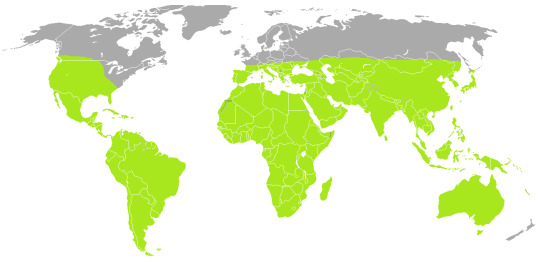
That's Wikipedia's map of the native range of the Scorpiones order, i.e., all scorpion species. You may notice something -- the range just stops at a certain northern latitude. Pretty much all of northern Europe is scorpion-free. If you lived in the north half of Europe, odds were good you had never seen a scorpion in your life. But if you were literate or educated at all, or you knew they were a thing, because you'd almost certainly run across them being mentioned in texts from farther south. And those texts wouldn't bother to explain what a scorpion was, of course -- everyone knows scorpions, right? When was the last time you stopped to explain What Is Spiders?
So medieval writers and artists in northern Europe were kind of stuck. There was all this scorpion imagery and metaphor in the texts they liked to work from, but they didn't really know what a scorpion was. Writers could kind of work around it (there's a lot of "oh, it's a venomous creature, moving on"), but sometimes they felt the need to break it down better. For this, of course, they'd have to refer to a bestiary -- but due to Bestiary Telephone and the persistent need of bestiary authors to turn animals into allegories, one of the only visual details you got on scorpions was that they... had a beautiful face, which they used to distract people in order to sting them.
And look. I'm not here to yuck anyone's yum, but I would say that a scorpion's face has significant aesthetic appeal only for a fairly small segment of the population. I'm sure you could get an entomologist to rhapsodize about it a bit, but your average person on the street will not be entranced by the face of a scorpion. So this did not help the medieval Europeans in figuring out how to depict scorpions. There was also some semantic confusion -- see, in some languages (such as Old and Middle English), "worm" could be a general term for very small animals of any kind. But it also could mean "serpent".* So there were some, like our artist at the top of the post, who were pretty sure a scorpion was a snake. This was probably helped along by the fact that "venomous" was one of the only things everyone knew about them, and hey, snakes are venomous. Also, Pliny the Elder had floated the idea that there were scorpions in Africa that could fly, and at least one author (13th-century monk Bartholomaeus Anglicus) therefore suggested that they had feathers. I don't see that last one coming up much, I just share it because it's funny to me.
*English eventually resolved this by borrowing the Latin vermin for very small animals, using the specialized spelling wyrm for big impressive mythical-type serpents, and sticking with the more specific snake for normal serpents.
Some authors, like the anonymous author of the Ancrene Wisse, therefore suggested that a scorpion was a snake with a woman's face and a stinging tail. (Everyone seemed to be on the same page with regards to the fact that the sting was in the tail, which is in fact probably the most recognizable aspect of scorpions, so good job there.) However, while authors could avoid this problem, visual artists could not. And if you were illustrating a bestiary or a calendar, including a scorpion was not optional. So they had to take a shot at what this thing looked like.
And so, after this way-too-long explanation, the thing you're probably here for: inaccurate medieval drawings of scorpions. (There are of course accurate medieval drawings of scorpions, from artists who lived in the southern part of Europe and/or visited places where scorpions lived; I'm just not showing you those.) And if you find yourself wondering, "how sure are you that that's meant to be a scorpion?" -- all of these are either from bestiaries or from calendars that include zodiac illustrations.

11th-century England, MS Arundel 60. (Be honest, without the rest of this post, if I had asked you to guess what animal this was supposed to be, would you have ever guessed “scorpion”?)
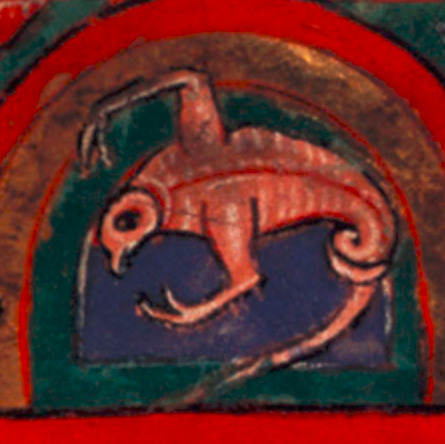
12th-century Germany, "Psalter of Henry the Lion". (Looks a bit undercooked. Kind of fetal.)
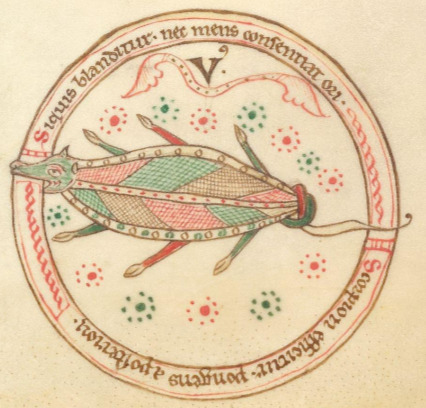
12th-century France, Peter Lombard's Sententiae. (Very colorful, itsy bitsy claws, what is happening with that tail?)

12th-century England, "The Shaftesbury Psalter". (So a scorpion is some sort of wyvern with a face like a duck, correct?)

13th-century France, Thomas de Cantimpré's Liber de natura rerum. (I’d give them credit for the silhouette not being that far off, but there���s a certain bestiary style where all the animals kind of look like that. Also note how few of these have claws.)

13th-century England, "The Bodley Bestiary". (Mischievous flying squirrel impales local man’s hand, local man fails to notice.)

13th-century England, Harley MS 3244. (A scorpion is definitely either a mouse or a fish. Either way it has six legs.)

13th-century England, Harley MS 3244. (Wait, no, it’s a baby theropod, and it has two legs. (Yes, this is the same manuscript, that’s not an error, this artist did four scorpions and no two are the same.))

13th-century England, Harley MS 3244. (Actually it’s a lizard with tiny ears and it has four legs.)

13th-century England, Harley MS 3244. (Now that we’re at the big fancy illustration, I think I’ve got it — it’s like that last one, but two legs, longer ears, and a less goofy face. Also I’ve decided it’s not pink anymore, I think that was the main problem.)

13th-century England, MS Kk.4.25. (A scorpion is a flat crocodile with a bear’s head.)

13th-century England, "The Huth Psalter". (Wyvern but baby! Does not seem to be enjoying biting its own tail.)
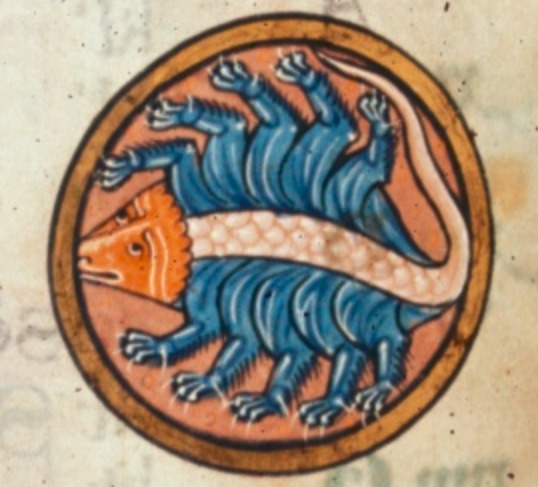
13th-century England, MS Royal 1 D X. (This triangular-headed gentlecreature gets the award for “closest guess at correct limb configuration”. If two of those were claws, I might actually believe this artist had seen a scorpion before, or at least a picture of one.)

13th-century England, "The Westminster Psalter". (A scorpion is the offspring of a wyvern and a fawn.)
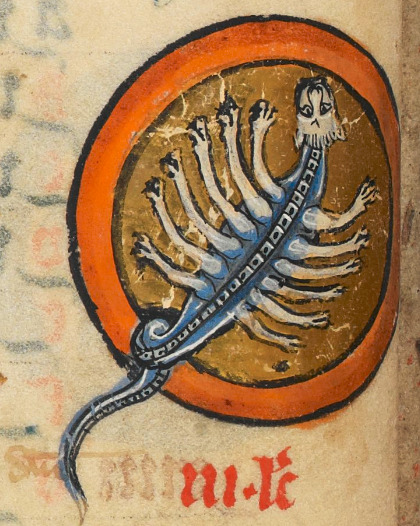
13th-century England, "The Rutland Psalter". (Too many legs! Pull back! Pull back!)

13th or 14th-century France, Bestiaire d'amour rimé. (This is very similar to the fawn-wyvern, but putting it in an actual Scene makes it even more obvious that you’re just guessing.)
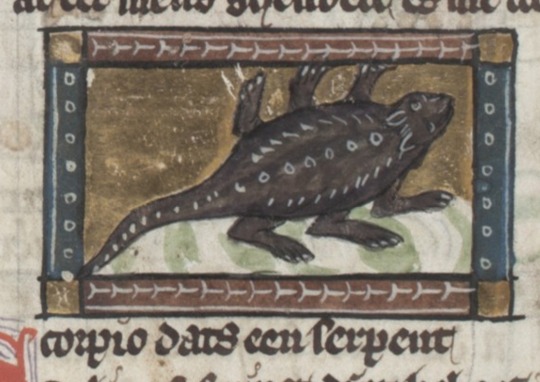
14th-century Netherlands, Jacob van Maerlant's Der Naturen Bloeme. (More top-down six-legged guys that look too furry to be arthropods.)
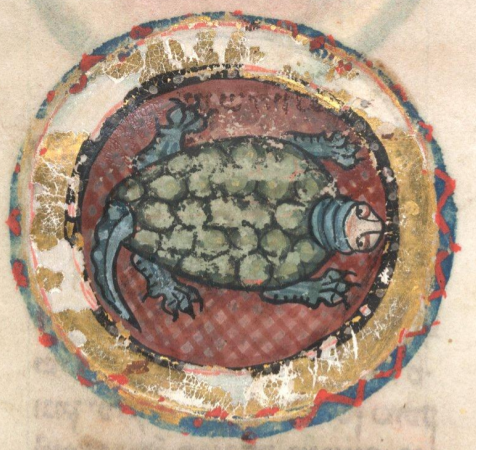
14th-century Germany, MS Additional 22413. (That is clearly a turtle.)

14th-century France, Matfres Eymengau de Beziers's Breviari d'amor. (Who came up with that head shape and what was their deal?)

15th-century England, "Bestiary of Ann Walsh". (Screw it, a scorpion is a big lizard that glares at you for trying to make me draw things I don’t know about.)
I've spent way too much time on this now. End of post, thank you to anyone who got all the way down here.
#medieval#medieval creatures#medieval art#scorpions#medieval scorpions#manuscript#medieval manuscripts#illuminated manuscript
6K notes
·
View notes
Text
Japanese illustrates the complex interaction between male social/political dominance and control of language use. It manifests not only the three ways patriarchal language infiltrates our minds and the ways we talk (or are permitted to talk) or are talked about by men, but also provides instances of women's defiance of PUD [Patriarchal Universe of Discourse] rules. When men name the world of their perceptions, they also name the place of women in that world; these names lexicalize men's concepts and form semantic sets within a culture's vocabulary. When men control the social and grammatical rules of a language and have mandated their dialect as the standard, they define what women are allowed to say and the way in which they must say it. The "place" of a woman in a man's world isn't only reflected in certain sets of words in the language's vocabulary but is also marked in her speech by specific suffixes. Japanese women aren't utterly silent, however, and have words for describing their own experiences, including derogatory terms for men.
In a 1988 Weekend Edition, National Public Radio (NPR) did a segment called "Japanese Women's Language." A man's voice introduced the segment as "a story about sexism, although most people in the country we're about to visit wouldn't call it that." Patronizingly acknowledging that, "of course, the United States has its share of sexism," he went on with his ethnocentric description of "sexism" in Japan:
now imagine a culture that forbids women most of the time to speak the same language as men, a society where women actually have to use different words than men do to say the same thing, or else they'll be shunned.
Men's subjugation of women in Japan goes back at least 1,000 years, to a time when women were forbidden to speak to men. In the 1930s, the Japanese government issued edicts warning women not to use words reserved to men, and the resulting differentiations remain in force, if not the edicts themselves (NPR). The significant adjectives that distinguish onna kotaba, 'women's words', from the male dialect are 'soft' and 'harsh', the equivalents of English 'weak' and 'forceful'. One example of the pressure on women to speak softly and submissively, if they speak at all, is the custom of hiring elevator "girls" in Japanese department stores.
According to the NPR report, women hired as elevator "girls" must be "pretty, young, and very, very feminine." One of the behaviors that conveys onna-rashisa (the stereotype of femininity) is the ability to speak women's "language" correctly, and this aspect of the elevator operator's job performance is closely monitored. They are expected to talk in "perfect women's language," and "never slip and use a masculine word." Their fluency in the linguistic display of submissiveness is insured by one-half hour of mandatory daily practice, during which any "unfeminine" pronunciations are corrected. In order for a woman, any woman, to be perceived as "nice," she must speak "correct women's language" (NPR). Women who don't speak the submissive dialect men assign to them don't get jobs.
R. Lakoff (1975) and Mary Ritchie Key (1975) both noted that the sentences of English-speaking women are likely to be longer and wordier than those of men, and the same apparently holds true for Japanese. A man might be able to say, "Open the window!" but a Japanese woman, in order to get the same thing done, would have to say, "Please open the window a little bit, if you don't mind!" The result is that a woman's sentence has only one or two words in common with a comparable male utterance (NPR) and is much longer. Not surprisingly, Japanese women's dialect is perceived as more subservient and tentative than men's, because the women must use submissive, self-effacing phrases equivalent to the tag-questions that Robin Lakoff (1975) associated with women's speech in English. These phrases translate into English as "do you think," "I can't be sure," and "will it be," and their use in commonplace statements means that Japanese women say an average of 20% more words than men to describe the same thing. In Japanese, it is impossible for a woman to speak informally and assertively at the same time (NPR).
-Julia Penelope, Speaking Freely: Unlearning the Lies of the Fathers’ Tongues
#julia penelope#japanese language#female oppression#patriarchy#women’s language#perhaps women are stereotyped as being more talkative because men force them to do so#linguistics
34 notes
·
View notes
Text

Lucky☆Star
らき☆すた
(Anime)
Slice of life by Kagami Yoshimizu
Era: 2000s
Rating: A
Plot: Four high school girls debate the hot topics of the day.
Length: 24 episodes + 1 OVA (~50 minutes)
Thoughts: So, I've seen plenty of originals, straight adaptations with varying levels of fidelity and filler, "you do you" adaptations like Excel Saga, variations over the original material like 16-Bit Sensation, "this is a fighting game so here's two pages outlining the characters" like Virtua Fighter, but I *think* this is the first time I saw something that was based on a four panel comic. The result are mostly complete scatterbrained mini-stories (the OVA does a bit more structured stories) that only get more bizarre the longer they get, as the girls discuss important topics such as the proper way to eat a chocolate cornet, the effect going to the beach has on hair, dipping into your dad's eroge games collection, how extra innings in baseball and election coverage impact airing times of anime, the semantics of tsundere, going to Comiket, Gu***m, American sports team calling themselves "World Champions", and a varied assortment of shower thoughts the cast goes through in very weird ways, depending on the combination of characters present.
Speaking of, we have Konata Izumi, the blue-haired otaku, the Hiiragi twins, Tsukasa, the lazy ditz who's always catching strays and Kagami, the serious and smart one and finally Miyuki Takara, the moe type of the group. In addition there's also Nanako Kuroi, homeroom teacher of the girls (except Kagami) who spends most of her time playing the same online game as Konata, Yui Narumi, Konata's older cousin who for everyone's surprise manages to hold her to her job as a traffic warden, and Konata's father Soujirou, a writer who may have influenced her otaku ways and uh, has a type. Then there's also Akira Kogami, a 14 year old idol who cheerfully presents the final segments of the show, Lucky Channel... until something that presents a threat to her position (usually from Minoru, her cohost she constantly threatens over what she sees as getting a bit too big for his britches) emerges. In the end stretch freshmen Yutaka (Konata's younger sister) and her friend Minami join to add additional "just what am I watching" moments to it.
Yeah, look, it's fun. That's around as much as you need to know. In a way, the constant references to anime and the kind of enjoyment you get from Konata's references reminds me of Excel Saga, although infinitely much less hyper and in a more Seinfeldian way. Is this an anime about nothing? Yeah, maybe. Since it's based on a 4 panel manga, there isn't anything resembling a plot or coherent stories, it's just a chain of random thoughts going through the characters' heads. So, is it an unscripted comedy podcast living on riffs they get tired of in 5 minutes? You know what? Yes.
Recommended to: fans of fast paced references
Plus:
It can be legitimately funny on how a random topic can come up, and then turn into a bizarre train of thought by one or two of the characters.
Timoteeeeei
Minus:
It can vary on quality, but since a bit you don't get might last anything from thirty seconds to two minutes, it's not a great deal.
7 notes
·
View notes
Note
ok um since we're getting on the semantics topic i hope i won't sound too disrespectful or something-
i personally see the term 'system' as a "combination of parts working together" (and that's the reason why i didn't relate to it at time - we didn't feel like working together) but honestly it feels like everybody has their own definition of this term =3= and it's also the thing with other terms, i can't come up with an example rn but i see misunderstandings due to different definitions quite often in syscourse
(okay as i wrote the whole thing i figured out a lot of people have different definition of 'endo', from 'people who claim to have DID without trauma' to simply 'systems without trauma' so yeahhhh (ALSO SORRY FOR THE POSSIBLE LACK OF NUANCE IN THIS SEGMENT i don't have spoons for obligatory notes about EVERYTHING I SAY))
and as a person who was fixated on linguistics at some time... I'm afraid terms can't be easily changed when they're already massively used, that's not how language works unfortunately /neu /info
i know internet language fluctates faster with slang and everything, but... I'm afraid even if someone comes up with another term for 'endogenic system' it will be very, VERY hard to get it used massively
(maybe the situation with 'tulpagenic' –> 'willogenic' might repeat in this case sorry but i had to bring it up as an example)
that's just my opinion tho, I'm not an expert in anything and English is not even my first language to speak for sure
That's definitely true, it's hard to make anything change with language once it's used for a while. (Even if said language is harmful; like the r-slur for example. People still use it constantly despite it being a horrible slur, arguably as offensive as the n-word)
But at the same time, that doesn't mean that we shouldn't try to get things to change. I mean, it's possible that syscourse could go on just the same as it is now for 50 more years, but that doesn't mean we shouldn't have these conversations
(Not saying you were implying there's no point in trying)
But yeah, no one seems to be able to agree one what it even means, and truthfully, I don't think we'll ever get anywhere at all unless we can come to some kind of consensus on what it means that isn't heavily based on stance. And with the history of the word apparently being so muddied, to the point where it's hard to say at ALL which side is right, idk if we'll ever come to an agreement.
We still firmly believe that it's a collection of alters in the context of plurality, and not just any parts at all.
-Laika
#sorry for getting philosophical on yall#anti endo#syscourse#syspunk#osdd system#system#systempunk#traumagenic system#osdd#osddid#actual system
9 notes
·
View notes
Text
We all can understand that Esperanto's system of using word-final vowels to denote word classes is not especially naturalistic and frankly is pretty clunky in many regards. However, there do appear to exist languages in numerous places around the world which exhibit some segmental correlates of word-class. Here's a list of those that I'm aware of off the top of my head.
Yoruba (and I'm guessing this is true of Kwa more broadly) appears to overwhelmingly have vowel-initial nouns in native vocabulary. This seems to tie in with a trend towards deriving nouns from consonant-initial verb roots using V-prefixes, as well as perhaps being a relic of a previous noun class system (more on that below).
Salishan languages (outside of Bella Coola) generally show an s- prefix, even on seeming root nouns, in part doubtless to do with it being a nominalising prefix and thus kinda essential in an omnipredicative language.
A number of Oceanic languages, mostly in Melanesia, have either vowel-initial or n-initial nouns from univerbation of one of the Proto-Oceanic articles (*qV and *na respectively). Often the distribution seems to fall along semantic lines, with *qi for humans and proper nouns and *na everything else, though some languages divide it differently, e.g. Torres-Banks, where *na has specifically ended up as an inalienable marker, though there it is still kind of an article. Notably, even in languages where this correlation does not hold for the majority of nouns, some 'article accretion' as François terms it often still occurs
Moskona, in a curious parallel to the Oceanic system, has native alienable nouns begin with m- and inalienable ones with a vowel, or rather the root begins with vowel to which possessor prefixes are added. No clues as to the etymology.
To this we might add systems where noun class also plays a role. For instance, in Berber languages masculine nouns seem to usually begin with a vowel, with a t-...-t circumfix for feminines, e.g. Amazigh 'Berber people' → Tamazight 'Berber language' (though for non-Tuareg varieties I think vowel syncope obscures this a little?). Similarly, some Bantu noun-class systems such as those of isiZulu have a vocalic 'augment' to their noun class prefixes which is basically an echo vowel of the prefix, which I suspect is related to what's going on in Yoruba, especially if Niger-Congo is a thing.
Any other examples you're aware of feel free to add, as I'm wondering if this might be a good thing to do a paper on sometime.
30 notes
·
View notes
Text
Google Cloud’s BigQuery Autonomous Data To AI Platform

BigQuery automates data analysis, transformation, and insight generation using AI. AI and natural language interaction simplify difficult operations.
The fast-paced world needs data access and a real-time data activation flywheel. Artificial intelligence that integrates directly into the data environment and works with intelligent agents is emerging. These catalysts open doors and enable self-directed, rapid action, which is vital for success. This flywheel uses Google's Data & AI Cloud to activate data in real time. BigQuery has five times more organisations than the two leading cloud providers that just offer data science and data warehousing solutions due to this emphasis.
Examples of top companies:
With BigQuery, Radisson Hotel Group enhanced campaign productivity by 50% and revenue by over 20% by fine-tuning the Gemini model.
By connecting over 170 data sources with BigQuery, Gordon Food Service established a scalable, modern, AI-ready data architecture. This improved real-time response to critical business demands, enabled complete analytics, boosted client usage of their ordering systems, and offered staff rapid insights while cutting costs and boosting market share.
J.B. Hunt is revolutionising logistics for shippers and carriers by integrating Databricks into BigQuery.
General Mills saves over $100 million using BigQuery and Vertex AI to give workers secure access to LLMs for structured and unstructured data searches.
Google Cloud is unveiling many new features with its autonomous data to AI platform powered by BigQuery and Looker, a unified, trustworthy, and conversational BI platform:
New assistive and agentic experiences based on your trusted data and available through BigQuery and Looker will make data scientists, data engineers, analysts, and business users' jobs simpler and faster.
Advanced analytics and data science acceleration: Along with seamless integration with real-time and open-source technologies, BigQuery AI-assisted notebooks improve data science workflows and BigQuery AI Query Engine provides fresh insights.
Autonomous data foundation: BigQuery can collect, manage, and orchestrate any data with its new autonomous features, which include native support for unstructured data processing and open data formats like Iceberg.
Look at each change in detail.
User-specific agents
It believes everyone should have AI. BigQuery and Looker made AI-powered helpful experiences generally available, but Google Cloud now offers specialised agents for all data chores, such as:
Data engineering agents integrated with BigQuery pipelines help create data pipelines, convert and enhance data, discover anomalies, and automate metadata development. These agents provide trustworthy data and replace time-consuming and repetitive tasks, enhancing data team productivity. Data engineers traditionally spend hours cleaning, processing, and confirming data.
The data science agent in Google's Colab notebook enables model development at every step. Scalable training, intelligent model selection, automated feature engineering, and faster iteration are possible. This agent lets data science teams focus on complex methods rather than data and infrastructure.
Looker conversational analytics lets everyone utilise natural language with data. Expanded capabilities provided with DeepMind let all users understand the agent's actions and easily resolve misconceptions by undertaking advanced analysis and explaining its logic. Looker's semantic layer boosts accuracy by two-thirds. The agent understands business language like “revenue” and “segments” and can compute metrics in real time, ensuring trustworthy, accurate, and relevant results. An API for conversational analytics is also being introduced to help developers integrate it into processes and apps.
In the BigQuery autonomous data to AI platform, Google Cloud introduced the BigQuery knowledge engine to power assistive and agentic experiences. It models data associations, suggests business vocabulary words, and creates metadata instantaneously using Gemini's table descriptions, query histories, and schema connections. This knowledge engine grounds AI and agents in business context, enabling semantic search across BigQuery and AI-powered data insights.
All customers may access Gemini-powered agentic and assistive experiences in BigQuery and Looker without add-ons in the existing price model tiers!
Accelerating data science and advanced analytics
BigQuery autonomous data to AI platform is revolutionising data science and analytics by enabling new AI-driven data science experiences and engines to manage complex data and provide real-time analytics.
First, AI improves BigQuery notebooks. It adds intelligent SQL cells to your notebook that can merge data sources, comprehend data context, and make code-writing suggestions. It also uses native exploratory analysis and visualisation capabilities for data exploration and peer collaboration. Data scientists can also schedule analyses and update insights. Google Cloud also lets you construct laptop-driven, dynamic, user-friendly, interactive data apps to share insights across the organisation.
This enhanced notebook experience is complemented by the BigQuery AI query engine for AI-driven analytics. This engine lets data scientists easily manage organised and unstructured data and add real-world context—not simply retrieve it. BigQuery AI co-processes SQL and Gemini, adding runtime verbal comprehension, reasoning skills, and real-world knowledge. Their new engine processes unstructured photographs and matches them to your product catalogue. This engine supports several use cases, including model enhancement, sophisticated segmentation, and new insights.
Additionally, it provides users with the most cloud-optimized open-source environment. Google Cloud for Apache Kafka enables real-time data pipelines for event sourcing, model scoring, communications, and analytics in BigQuery for serverless Apache Spark execution. Customers have almost doubled their serverless Spark use in the last year, and Google Cloud has upgraded this engine to handle data 2.7 times faster.
BigQuery lets data scientists utilise SQL, Spark, or foundation models on Google's serverless and scalable architecture to innovate faster without the challenges of traditional infrastructure.
An independent data foundation throughout data lifetime
An independent data foundation created for modern data complexity supports its advanced analytics engines and specialised agents. BigQuery is transforming the environment by making unstructured data first-class citizens. New platform features, such as orchestration for a variety of data workloads, autonomous and invisible governance, and open formats for flexibility, ensure that your data is always ready for data science or artificial intelligence issues. It does this while giving the best cost and decreasing operational overhead.
For many companies, unstructured data is their biggest untapped potential. Even while structured data provides analytical avenues, unique ideas in text, audio, video, and photographs are often underutilised and discovered in siloed systems. BigQuery instantly tackles this issue by making unstructured data a first-class citizen using multimodal tables (preview), which integrate structured data with rich, complex data types for unified querying and storage.
Google Cloud's expanded BigQuery governance enables data stewards and professionals a single perspective to manage discovery, classification, curation, quality, usage, and sharing, including automatic cataloguing and metadata production, to efficiently manage this large data estate. BigQuery continuous queries use SQL to analyse and act on streaming data regardless of format, ensuring timely insights from all your data streams.
Customers utilise Google's AI models in BigQuery for multimodal analysis 16 times more than last year, driven by advanced support for structured and unstructured multimodal data. BigQuery with Vertex AI are 8–16 times cheaper than independent data warehouse and AI solutions.
Google Cloud maintains open ecology. BigQuery tables for Apache Iceberg combine BigQuery's performance and integrated capabilities with the flexibility of an open data lakehouse to link Iceberg data to SQL, Spark, AI, and third-party engines in an open and interoperable fashion. This service provides adaptive and autonomous table management, high-performance streaming, auto-AI-generated insights, practically infinite serverless scalability, and improved governance. Cloud storage enables fail-safe features and centralised fine-grained access control management in their managed solution.
Finaly, AI platform autonomous data optimises. Scaling resources, managing workloads, and ensuring cost-effectiveness are its competencies. The new BigQuery spend commit unifies spending throughout BigQuery platform and allows flexibility in shifting spend across streaming, governance, data processing engines, and more, making purchase easier.
Start your data and AI adventure with BigQuery data migration. Google Cloud wants to know how you innovate with data.
#technology#technews#govindhtech#news#technologynews#BigQuery autonomous data to AI platform#BigQuery#autonomous data to AI platform#BigQuery platform#autonomous data#BigQuery AI Query Engine
2 notes
·
View notes
Text
CosmicLuve.com December 2023 - Deer
Necessary prerequisite posts:
108 The Story of Discovering Earth’s Consciousness (book)
Sentientism 2022
Cosmic Love Feb 2020 - Emma Watson
Cosmic Love April 2022: Cary Charlotte or Mary
Cosmic Luve July 2023 - The Main Thing
Cosmic Luve Aug 2023 - Orange
Cosmic Luve Sept 2023 - Bam
Cosmic Luve November 2023 - Cosmic Bros
youtube
This post’s intro builds off the semantics from the cosmic luve entries “Bam” and “Cosmic Bros” but the semantics for this month are all new, and all surround Emma Watson (again). I keep up this blog to show how semantic coincidences I see as meaningful could be a communication from Gaia, which is another name for the Earth’s conscious and godly spirit.
The basic theory is that Gaia can communicate through telepathic randonauting and “points of realization.” In other words, it’s thought that the Earth is conscious due to it’s magnetism that gives her the ability to read your thoughts and highlight cognition which affects your behavior. It’s postulated that Gaia would manifest her communications through signals of loving intent especially between romantic partners. She would basically have to use humans and animals as a canvas to paint her communication over the collective ethos which would manifest by groups of individuals acting out their (gaia) affected cognition.
The basis of this is described in my book “108 The Story of Discovering Earth’s Consciousness” which breaks down the science and evidence behind my reasoning and why I came to this conclusion. In the sentientism posts on the blog I take the science and knowledge of this a step further into the belief that Gaia is already conscious and communicating and ask: “What would that look like?” Then, this cosmic luve log is my attempt at showing you all that from my experience and how the voice in my head predicts the future and manipulates my environment in the ways aforementioned.
Where we Left off

I guess I should have waited longer to publish the last post because a couple new semantics popped up that day that directly related to the main theme of the last post. I’ve seen the video of Pattie Gonia holding up the signs of exposing Big Oil Tycoons as criminals before… but I forgot to log it. I made a tweet about it and about how I came across it on the day I published the November 2023 post and (eventually) apologized to Gaia for missing her communication. The next day, Philip DeFranco did another segment on the protests of Just Stop Oil.
New Coincidences
youtube
It all started December 9th, 2023 when I went to Three Rivers to see a friend and shoot three one-take music videos on the train tracks. They are posted and include “Yeah We Bang” “I Got You” and “Paliperidone” which is embedded above. In the December 10th Sunday update I talked about Emma Watson as a dear. Quick explanation, there was a deer that stopped in the middle of the train tracks while I was filming the second video which was “Paliperidone.” This is cosmic luve because right as I’m filming the deer I say “Gaia’s force,” then a little later I say “here’s the tale” as the deer runs away showing it’s tail, and (at the time) Emma’s Instagram profile picture was the mother deer from Bambi.
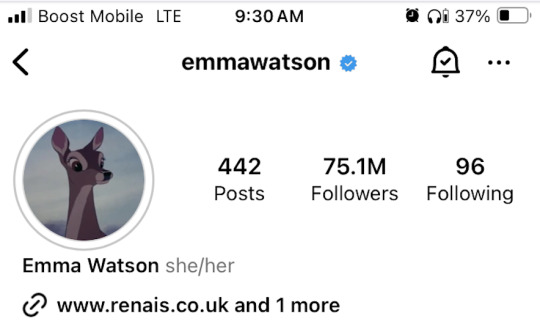
In the December 10th Sunday update I also talk about how “in twilight while taking a nap during the day the other day and Gaia said to make a (mystical) tree an anchor that she could build upon so I tweeted it to make it official.” Here is the tweet about the tree. I mentioned how “I made a tweet back on October 1st about how I would get $500 from my music “in the next 100 days”. Well I got the $500 but it didn’t come from music. It was access money I had basically.” Here is the tweet I made on October 1st. I also logged in the update that Gaia said I would meet Hailee Steinfeld in two years.

On December 11th I uploaded the Paliperidone One Take music video to Youtube. On the night of December 12th, Jimmy Fallon revealed the 9th box ‘til Christmas day’ sweater and it was a deer. Also on the night of December 12th Taraji P Henson was on Steven Colbert promoting the movie she was in which was “The Color Purple.” In the interview Taraji talk about how they shot the movie around a big oak tree (recalling what Gaia told me in twilight). The movie clip in the show is about recognizing god’s love.

On October 13 “Cosmic live brownies” dropped. I made a couple posts asking my ig audience why Emma Watson's profile picture is the deer from Bambi. On December 14 Emma changed her profile picture to a British vogue shot and lil dicky dropped mr McAdams the same day. Do you think this is Gaia making fun of me using Emma as a vessel? I think she is. On that day I also thought about the song “Do-Re-Me” from Sound of Music which I think relates especially with Emma being tied to the sun poem. That night Oprah made an appearance on Stephen Colbert wearing all purple.
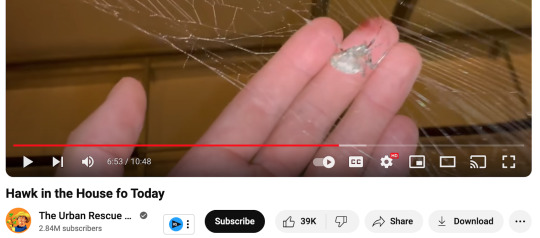
On December 15th Gaia compelled me to make the tweet saying “Gaia says “you’ll hand a girlfriend in three weeks.”” I still don’t know what that’s about, we’ll see… On December 18th the Urban Rescue Ranch talks about “charlottes web” at 6:50 and how the spider is protecting Patrick, who I think is a type of African or Australian deer, from flies. I just want to say, this is how Emma’s cat semantics developed that I talk about in the book, the difference is the semantics were a lot more frequent and consistent because I had a cat. The problem was I hadn’t developed my theory of Gaia’s system (ie, knhoeing, sentientism, and cosmic luve) yet.
This will be a pivotal post because it’s all about Emma Watsan, and draw together semantics from the previous trope. Listen to “Hey Emma” and “Be my dream” for music about Emma Watson. “Charlotte’s Web,” the last remake from ‘The Chalice Mixtape’ drops on Emma’s birthday April 15 2024.
youtube
I am now using threads to document cosmic Luve coincidences so future logs will link to threads to document the prophecies instead of ‘X.'
25 notes
·
View notes
Text
Interesting Papers for Week 16, 2024
Signatures of cross-modal alignment in children’s early concepts. Aho, K., Roads, B. D., & Love, B. C. (2023). Proceedings of the National Academy of Sciences, 120(42), e2309688120.
Competing neural representations of choice shape evidence accumulation in humans. Bond, K., Rasero, J., Madan, R., Bahuguna, J., Rubin, J., & Verstynen, T. (2023). eLife, 12, e85223.
Initial conditions combine with sensory evidence to induce decision-related dynamics in premotor cortex. Boucher, P. O., Wang, T., Carceroni, L., Kane, G., Shenoy, K. V., & Chandrasekaran, C. (2023). Nature Communications, 14, 6510.
A large-scale neurocomputational model of spatial cognition integrating memory with vision. Burkhardt, M., Bergelt, J., Gönner, L., Dinkelbach, H. Ü., Beuth, F., Schwarz, A., … Hamker, F. H. (2023). Neural Networks, 167, 473–488.
Human thalamic low-frequency oscillations correlate with expected value and outcomes during reinforcement learning. Collomb-Clerc, A., Gueguen, M. C. M., Minotti, L., Kahane, P., Navarro, V., Bartolomei, F., … Bastin, J. (2023). Nature Communications, 14, 6534.
Large-scale recording of neuronal activity in freely-moving mice at cellular resolution. Das, A., Holden, S., Borovicka, J., Icardi, J., O’Niel, A., Chaklai, A., … Dana, H. (2023). Nature Communications, 14, 6399.
Top-down control of exogenous attentional selection is mediated by beta coherence in prefrontal cortex. Dubey, A., Markowitz, D. A., & Pesaran, B. (2023). Neuron, 111(20), 3321-3334.e5.
The priming effect of rewarding brain stimulation in rats depends on both the cost and strength of reward but survives blockade of D2‐like dopamine receptors. Evangelista, C., Mehrez, N., Boisvert, E. E., Brake, W. G., & Shizgal, P. (2023). European Journal of Neuroscience, 58(8), 3751–3784.
Different roles of response covariability and its attentional modulation in the sensory cortex and posterior parietal cortex. Jiang, Y., He, S., & Zhang, J. (2023). Proceedings of the National Academy of Sciences, 120(42), e2216942120.
Input-specific synaptic depression shapes temporal integration in mouse visual cortex. Li, J. Y., & Glickfeld, L. L. (2023). Neuron, 111(20), 3255-3269.e6.
Dynamic emotional states shape the episodic structure of memory. McClay, M., Sachs, M. E., & Clewett, D. (2023). Nature Communications, 14, 6533.
Trajectories through semantic spaces in schizophrenia and the relationship to ripple bursts. Nour, M. M., McNamee, D. C., Liu, Y., & Dolan, R. J. (2023). Proceedings of the National Academy of Sciences, 120(42), e2305290120.
Contribution of dorsal versus ventral hippocampus to the hierarchical modulation of goal‐directed actions in rats. Piquet, R., Faugère, A., & Parkes, S. L. (2023). European Journal of Neuroscience, 58(8), 3737–3750.
Neural dynamics underlying successful auditory short‐term memory performance. Pomper, U., Curetti, L. Z., & Chait, M. (2023). European Journal of Neuroscience, 58(8), 3859–3878.
Temporal disparity of action potentials triggered in axon initial segments and distal axons in the neocortex. Rózsa, M., Tóth, M., Oláh, G., Baka, J., Lákovics, R., Barzó, P., & Tamás, G. (2023). Science Advances, 9(41).
Working memory and attention in choice. Rustichini, A., Domenech, P., Civai, C., & DeYoung, C. G. (2023). PLOS ONE, 18(10), e0284127.
Acting on belief functions. Smith, N. J. J. (2023). Theory and Decision, 95(4), 575–621.
Thalamic nucleus reuniens coordinates prefrontal-hippocampal synchrony to suppress extinguished fear. Totty, M. S., Tuna, T., Ramanathan, K. R., Jin, J., Peters, S. E., & Maren, S. (2023). Nature Communications, 14, 6565.
Single basolateral amygdala neurons in macaques exhibit distinct connectional motifs with frontal cortex. Zeisler, Z. R., London, L., Janssen, W. G., Fredericks, J. M., Elorette, C., Fujimoto, A., … Rudebeck, P. H. (2023). Neuron, 111(20), 3307-3320.e5.
Predicting the attention of others. Ziman, K., Kimmel, S. C., Farrell, K. T., & Graziano, M. S. A. (2023). Proceedings of the National Academy of Sciences, 120(42), e2307584120.
#neuroscience#science#research#brain science#scientific publications#cognitive science#neurobiology#cognition#psychophysics#neurons#neural computation#neural networks#computational neuroscience
16 notes
·
View notes
Text
Loon drawing :D love her im killing her
Heavily inspider by the song "Bouquet Garni" by nilfruits! it's really good I reccomend checking it out :9
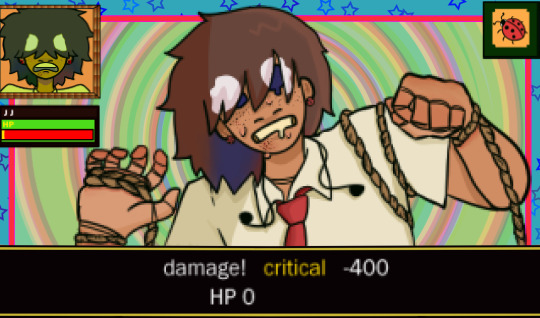
hey girl, ever have breakdowns and the only way you can somehow hold yourself back from going full insane is thinking back to all the shitty videogames you consume in the comfort of your own room? if so then you have something in common with her !1!1! hasashgihasg breakdown (videogame flavored)
I'll go a bit more in depth on him under the cut since I figured we changed quite a tad about her and I want to spread wisdom (our AU) to the world
So I'll start with design choices and then I'll move to his general character ヾ(≧▽≦*)o So:
The things coming out from his neck are antennae! they make her have really good hearing which SUCKS when you are overwhelmed (which she is, always) so rip!
His eyes have no pupil because arthropods and insects have them freaky eyes now <3
He has blue and red dyed hair to match the animatronics color scheme (thought the red is not very obvious here since he's tilting his head), though the white bits of his hair are not actually dyed! they are like that because he's a ladybug and they have those white spots on the sides of their little heads!
-His hands are segmented like that because of an arbitrary rule I made to make arthropods more recognizable amongst them bears and foxes and allat, since a arthropods are segmented I applied that to their articulations! fun fact, insects like Loon or Cami (We made her a mantis I'm sorry) have a division on their neck, while arthropods that are NOT insects, like Owynn, completely lack that! that's because insects are divided in 3 parts (head thorax and abdomen) arachnids are divided in 2 (thorax and abdomen) ((not exactly called that but semantics)).
-He has little ladybug earrings and actually he matches with Malva!(Usagi) ((we changed her name lol)) ((her last name is visco haha get it malva-visco))
-In general I made his hair darker, gave him a bit of acne amongst the freckles and made him more tan because we love melanin in this house
Now for,, character changes,,,
So first of all, he/she swag, bigender, Loon when masc and JJ when fem though it fluctuates too, good for her gettem. We obliterated that Malva crush, gone, exploded into pieces, and also she's ecuadorian now, gettem.
We turned that pathetic nervous shy thing of his into something way worse </3 She is still introverted and all that, but the main thing is that she does not like going outside! gamer goes outside challenge impossible, she does NOT like leaving his house shut-in guy who if outside for long enough has a breakdown, clings to Malva because they are best friends and she's like "safe" she's like a safe zone. Loon cannot function in social/public settings at all and just clings, which is also why a lot of people mistake him as "having a crush on her" even though they are a bajillion percent platonic
He's a bit of a cringefail loser and also a bit creepy lmao, always on her phone always trying to zone the hell out and think about a silly videogame, but also just nosy, hit antennae and insect stuff lets him 1) look wherever without people being able to tell, and 2) listen to stuff. So yeah, his ass sorta psychoanalyzes people and snoops through stuff to kinda distract herself from the horrors of being outside, which is why in this AU she's dating Owynn T-T sorta like the animatronic she isn't like actually out to get you, but instead acts like some sort of aid for the real enemy, which is Owynn, so yeah. Enabler and snoops through shit AKA has good info for Owynn's insane as shit ideas, insane of her but whatever.
Also given how in this Au we cranked the animal motifs to a thousand, being a little "bug" and then being next to like, a bear is terrifying to her, so besides being scared of just existing outside, she's also scared of people as a whole because little insect vs big animal, rip.
And i think that's most of it, if anyone read all of this and has any questions feel free to ask T-T sorry if the formatting SUCKS it's the first time I've tried putting something this long on tumblr <//3
#πa art#fnafhs#fhs#fhs fanart#fnafhs au#fnafhs fanart#loon fnafhs#loon fhs#the background was a nightmare to make#our au#<- we dont have a name yet woups
26 notes
·
View notes
Text
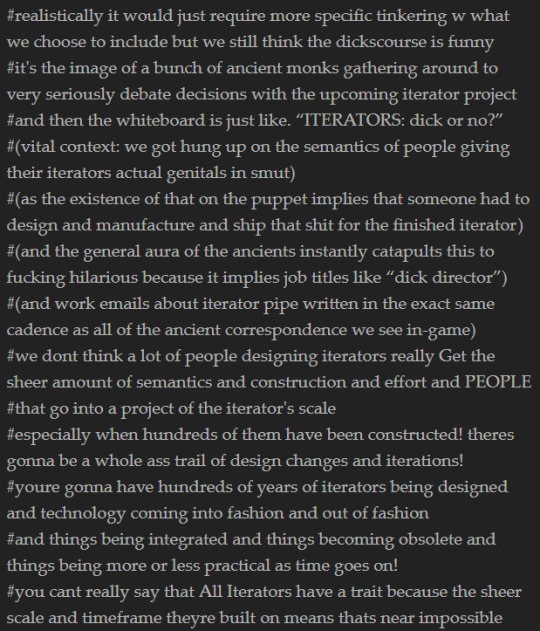
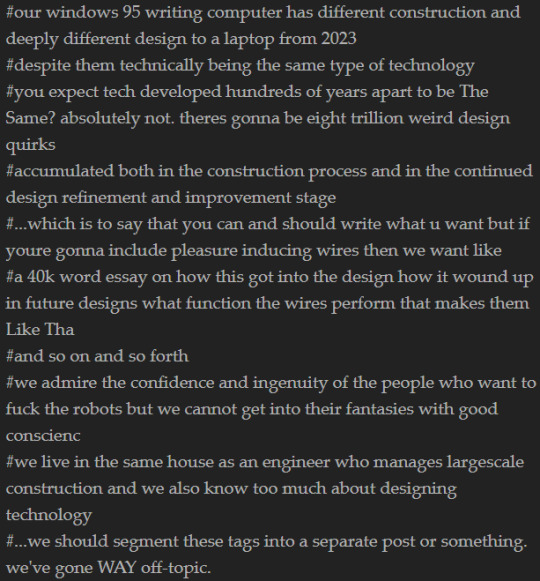
Tags from this post segmented off into a post of their own (if you don't want to click that link, then just the phrase "ancient iterator dick discourse" should suffice. We have strong opinions about iterator construction because we live with a guy who manages large-scale construction projects and such like this for a living and it's really hard to listen to half a dozen calls about the legalities of one (1) bridge and budgeting and materials construction and the legally mandated fund for art on major construction projects and then just buy in to hundreds of years of iterator designs using a single thing made by one guy without changing a single piece of it or at the very least having eighty engineers arguing the shit out of it.
Full transcript of text below cut.
#we speak #realistically it would just require more specific tinkering w what we choose to include but we still think the dickscourse is funny #it's the image of a bunch of ancient monks gathering around to very seriously debate decisions with the upcoming iterator project #and then the whiteboard is just like. “ITERATORS: dick or no?” #(vital context: we got hung up on the semantics of people giving their iterators actual genitals in smut) #(as the existence of that on the puppet implies that someone had to design and manufacture and ship that shit for the finished iterator) #(and the general aura of the ancients instantly catapults this to fucking hilarious because it implies job titles like “dick director”) #(and work emails about iterator pipe written in the exact same cadence as all of the ancient correspondence we see in-game) #we dont think a lot of people designing iterators really Get the sheer amount of semantics and construction and effort and PEOPLE #that go into a project of the iterator's scale #especially when hundreds of them have been constructed! theres gonna be a whole ass trail of design changes and iterations! #youre gonna have hundreds of years of iterators being designed and technology coming into fashion and out of fashion #and things being integrated and things becoming obsolete and things being more or less practical as time goes on! #you cant really say that All Iterators have a trait because the sheer scale and timeframe theyre built on means thats near impossible #our windows 95 writing computer has different construction and deeply different design to a laptop from 2023 #despite them technically being the same type of technology #you expect tech developed hundreds of years apart to be The Same? absolutely not. theres gonna be eight trillion weird design quirks #accumulated both in the construction process and in the continued design refinement and improvement stage #...which is to say that you can and should write what u want but if youre gonna include pleasure inducing wires then we want like #a 40k word essay on how this got into the design how it wound up in future designs what function the wires perform that makes them Like That #and so on and so forth #we admire the confidence and ingenuity of the people who want to fuck the robots but we cannot get into their fantasies with good conscience #we live in the same house as an engineer who manages largescale construction and we also know too much about designing technology #...we should segment these tags into a separate post or something. we've gone WAY off-topic.
#we speak#questionable content#rain world#iterators#technically some of this stuff isnt TOO out there for bad design decisions?#the library that sunk because they didnt account for it bearing the weight of the books comes to mind#but generally those things get caught and they dont last like. DECADES of design decisions especially when they have to house EVERYONE#shoddy design decisions affecting things for years generally happens in areas where not too many people are checking ur work#not on the very fundamentals of the city that everyone is going to have to live on#at the very least if theres a disastrous design flaw itll be the kind of thing that comes up years down the line#and becomes an anecdote they tell new iterator engineering students in design class for years to come#rather than sticking around in the design forever#everyone lives on that fucking robot.
10 notes
·
View notes
Text
Okay I actually have one more thing to say about Minecraft and the Minecraft Movie. (Sorry, A Minecraft Movie.) I’m seeing a lot of people make the claim that “they whitewashed Steve” and while I absolutely see where they’re coming from, I disagree semantically. “Whitewashing”, to me anyway, implies that Steve was at one point intended to be nonwhite before then Mojang changed their minds. This is not the case. Notch intended Steve to be white.
Should he have been intended to be white? I’m not gonna interrogate that. Take it up with a sociology professor. Should we care if was intended to be white? Probably not, for most intents and purposes. In vacuo it’s very easy to read Steve as racially ambiguous, and that reading is all that really matters for most players. But that’s not been the case behind the curtain.
(Warning: long post, slightly messy post ahead. I could revise it further but I’ve spent way to much time on this. Maybe if I was arguing something a little less easy to take as racism. Sorry about that, BTW.)
Exhibit 1 (↓) : The current Steve skin.

This hasn’t always been the default player model. Obviously, right? Look at those rolled-up sleeves, those haven’t always been there!
This (↓) is the original.
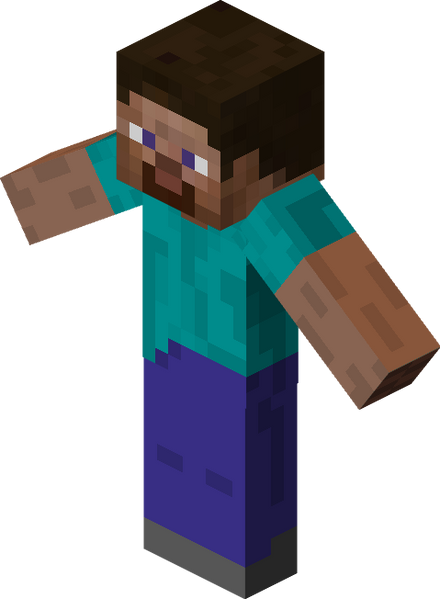
It’s May, 2009; and this new game–not yet called Minecraft–is still a very pliable thing. No “Minecraft Bible”, no brand identity to uphold, no vision for the future. There are almost no features here–it’ll be another 9 months before the game’s trademark–infinite terrain–gets added on a whim.
Note the differences between this first model and the current one: the slightly lighter skin shades, the weird harsh edges on the detailing, the jarring lack of detailing on the pants, etc. etc. This is a placeholder: it’s been copied from another abandoned game prototype, where it had been copied from a second, unrelated, abandoned game prototype. Like so much of Minecraft’s early development, it’s been thrown together just to see if it’d work. It’s haphazard.
What would Steve look like if he’d been, well, designed? Created with intent? We actually don’t have to wonder. For a brief period of time between December 2009 and February 2010, Mojang had an artist: Hayden ’Dock’ Scott-Baron. Not just a programmer who happened to be making textures. And this (↓) is the design they came up with:


That’s a white guy. Notch got the chance to redesign Steve, to clarify what he intended, and he went with making Steve a white guy.
Well, to be fair, they also made “Black Steve”. (↓)
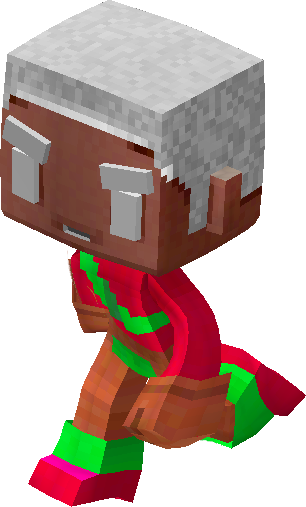
Yikes. “Black Steve”. I don’t know about you, but the fact that white Steve is just “Steve” and black Steve is “Black Steve” implies to me that this was a Mojang who thought of white as the default. Or at least that Notch thought of white as the default.
Dock would soon leave Mojang, and the game would never really get around to implementing any of his work. They stuck with Notch’s placeholder. And as the game got bigger and bigger, that placeholder became brand identity. By 2011 or 2012, Steve was too famous for them to go back and “correct” (and I mean that pejoratively) to white. (Not unlike creepers, but that’s another story)
And they’ve chafed under that ever since. Every depiction of Steve outside of the game itself has been obviously white, be it in promotional art, LEGO sets, the upcoming “film”, Super Smash Bros.–you name it, he’s white there. Mojang either hasn’t noticed or is unwilling to accept that anyone sees Steve any other way.
What should they do about this? Well, updating Steve to be unambiguously white in game would be pretty bad for what I hope are obvious reasons: bad optics, bad for their brand recognition, and really, really rude to anyone who didn’t think of him as white. They could also start depicting him accurate to his texture, but that might piss off racists. Pissing off racists is based, but you have to appeal to racists at least a little if you want to be the richest corporation in your market segment. They won’t go for that.
So what will they do? Nothing. Steve will continue to be an unambiguous white guy everywhere except Minecraft, where he’ll be treated like a white guy despite not exactly looking it. Is that whitewashing? I don’t think so. Whitewashing is deliberate, and this is a situation that’s evolved out of inertia more than anything else. But it isn’t much better than whitewashing.
#my thoughts#minecraft#just trying to explain some of the historical context for why jack black isnt really a break from anything established
4 notes
·
View notes